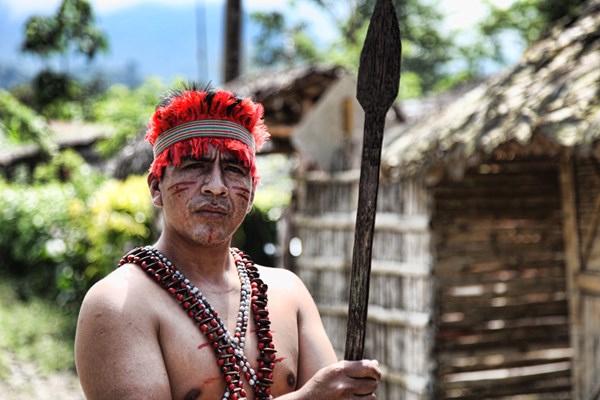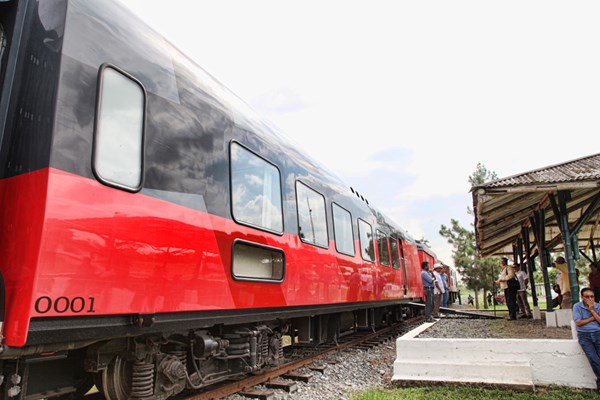QUITO, Ecuador, Aug. 14, 2013 (GLOBE NEWSWIRE) -- Posicionarte, a travel media agency, was invited to discover the brand new Ecuador's cruise train trip 4 days 3 nights from the Andes to Coast, it's travel editor Andrew Taylor takes us on a scenic train ride through the volcanic Ecuadorian Andes to meet the people of the Shuar nation.
It's the last day of their four day scenic train ride from the Ecuadorian highland capital of Quito, through the Avenue of Volcanoes they've stayed in a haunted hacienda, walked around a glacial lake, visited a rose plantation and a 4,000 year old remote, indigenous market and did the world famous Devil's Nose. Now they are walking up a path in the baking sun (pack a hat) to visit the Shuar Community from Limon River.
They're led into a large open shelter where an elder from the community begins proceedings by performing a ritual to cast out bad spirits. Then the children of the tribe perform a hunting dance. It's very athletic, shuffling and leaping, repetitive and rather hypnotic. It would make fantastic flash mob. When I think that the whole community knows this dance, it is powerful to imagine the euphoria it would produce amongst them.
After the hunt, the tribe have a three day ritual of thanksgiving to nature. "One woman showed us around their settlement and told us about their beliefs" Andrew tells us. "We stand on the edge of a near precipice leading down into a river, where she talks about the communities' affinity with water. She shows us their garden where only women plant and gather the food, the earth is considered female and requires female attendance."
To understand the Shuar from the inside, you need to imagine or believe that everything contains spirit. The shuar do not believe in what we might call "natural death", the idea Andrew supposes that we all just die of some illness or other eventually. They attribute illnesses to curses and evil spirits. Their traditions are very connected with natural remedies and rituals. They lived as semi nomadic hunter gatherers, only ever taking as much as they needed, and consuming with a reverence of gratitude. If they weren´t a culture of ancient origin, you'd almost call them New Age.
The Shuar (which simply means people) largely inhabit tropical rainforests and Savannas of the Amazonian lowlands of Ecuador and Peru. The Muraiya shuar live in the foothills of the Andes, the Achu shua (Achu means swamp palm) live in the wet lowlands East of the Andes.
They are distinguishable from other cultures for their former tradition of tsantsa, shrinking human heads. According to their beliefs, the head shrinking process had the effect of containing the muisak (the soul) of the enemy warrior, and allegedly increased their power over their women. Before the Missionaries got to them, survival meant a life-style of training warriors.
Andrew continues saying "As far as I could gather, at some infant age, a shuar boy was taken on a trail to the nearest waterfall, where after a fast (only drinking tobacco water) they would consume maito. This hallucinogenic brew evoked visions created by ancestral spirits. If the boy could touch the vision, he would enter a level of higher warrior consciousness. Another ritual is at puberty where the boy goes into the forest and lives alone for a month with the spirits. He returns a warrior."
Later, they visit the Uwishin, the shaman, who in Shuar culture is always a woman. The Uwishin, within Shuar tradition, is attributed with having the power to kill or cure. An unexplained death was believed to be caused by tsentsak, invisible deadly darts, something only possessed and controlled by shamans. The shaman was also, of course, the healer of the community performing rituals to balance the spirit and passing down ancient knowledge of Amazonian herbal medicine. For us visitors, the Uwishin of the Shuar de Limonar demonstrated a spiritual cleansing ritual.
They waved our goodbyes to the people of Shuar and sunk back into our seats on our luxury train with its bar and sofas and trundle away to a cacao plantation for lunch. At Yaguachi, the engine is changed to an original steam engine and with all the right pipe sounds and a lot of, well, letting off steam... they jump aboard and are joined by a jolly little band of musicians. It's the last stretch of an epic journey. They're now passing through platano, sugar cane and paddy fields onto the coastal city of Guayaquil. It's a farewell party and yes, many of the passengers are indeed doing the congo through all the wagons, or was it the locomotive?
The Tren Crucero's scenic journey experience is a fun, confidently engineered experience. The onboard team are very intelligent and personable and bring a fluidity, levity and reverence to cultural exchanges that are actually incredibly incongruous. The service is first class, and the trip is a thrill.
The overnight stays are worth a look around. I liked the La Cienega (34 rooms of rather eerie Andean luxury) built on a swamp.. Abraspungo had the most generous and comfortable beds and stylish en suite bathrooms. There are 42 rooms and they all come with under floor heating.) Eterna Primavera (with 37 rooms) offered more modest accommodation, but the salsa around the pool and the croon singer were hilarious.
Until New Years Eve 2013 the trip is $990 all inc. Have a look around the webpage where you can see the itinerary, maps, altitudes and a gallery of pictures to whet your appetite for a spectacular scenic journey by train.
Photos accompanying this release are available at:
http://www.globenewswire.com/newsroom/prs/?pkgid=20481
http://www.globenewswire.com/newsroom/prs/?pkgid=20482

